Human Hair Extensions
Remy Hair Extensions
The hair that is used for extensions can be human or synthetic. The hair is of great importance. It is for the greatest part responsible for the look and life span of your extensions.
Human hair extensions are still the most popular because it is the closest to your own hair. Synthetic hair however, has come a long way and is getting closer to natural hair.
The human hair used for extensions comes in a large variety. The different qualities depend on where and how the hair is collected and what kind of treatment is used.
One of the highest quality hair is Remy hair. This hair is never chemically treated in any way.
Low quality hair is cheaper of course but it can become a nightmare when used in hair extensions. It is chemically treated and this can result in dry, brittle hair that tangles constantly.
In general you can say that you get what you pay for.
It is important to know more about hair before you visit a salon. Below we'll discuss the different hair qualities.
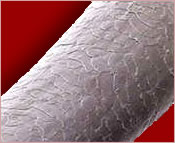
Healthy hair with natural cuticle
Human Hair - The Cuticle
Hair is made of different layers. The cuticle is the outer layer of the hair. It is made up of overlapping layers of long cells. All cuticles are aligned in the same direction like the tiles on a roof. Their free edges are directed towards the tip. The cuticles protect the hair from outside elements and lock in the necessary moisture. It is not just a protective layer. A healthy cuticle makes the hair shine. Light reflects from their glossy surfaces. This gives the hair its characteristic appearance in addition to the pigment within the cortex. Hair with damaged cuticles or no cuticles at all would appear dull and lifeless. It would dry out and break easy. Hair with all cuticle aligned in the same direction will tangle less, have a more natural flow and last longer.
Virgin Human Hair
The highest quality human hair available is virgin hair. It must meet very strict standards. The hair is very carefully collected from a single donor and is never chemically processed. This means never permed, colored, bleached etc.
Virgin human hair will have all cuticles perfectly line in the same direction. Because it is collected from one donor it all has the exact same texture. It has very little tangling and can often be reused.
How can you tell if it is virgin hair?
- Feel the cuticle - hold a strand of hair at the top between thumb and index finger and slide your hand down the entire length of the hair. The hair should feel smooth, you are going in the direction of the cuticle. Now do the same in then reverse the direction, the hair should feel more ridged because of the cuticle on the hair. If the hair is smooth both ways it means that the cuticles were stripped by an acid treatment.
- Lighter ends - In general the hair at the ends is lighter than the roots because of natural bleaching by the sun.
- Split ends - In general untreated hair will have a few split ends.
- Smell the hair - Chemically treated hair often smells like corn chips.
What is Remy Hair?
When shopping for hair extensions you will hear the name "Remy hair" a lot. Just as Virgin hair Remy hair will also have all cuticles perfectly aligned in the same directions. It is carefully collected in such a way that the cuticle is kept pointed in the same direction as the hair next to it. It is possible that this hair was permed or colored. Because of its natural flow Remy hair is softer and silkier. It is also less sensitive to tangling and knotting.
Remy Hair vs. Virgin Human Hair
Virgin hair and Remy hair are both top quality. The confusing part is that both terms are often used interchangeably. The term Remy hair is often used for virgin hair and vice versa.
When you hear the term "Virgin Remy hair" it means human hair from one donor with all cuticles lined in the same direction that has never been chemically treated.
When you are buying hair or ask about the hair being used for your extensions do not settle with just the name. Ask for details as mentioned earlier so you know that you and your stylist or supplier are talking about the same hair quality.
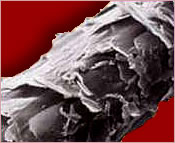
Bad hair with damaged cuticle
Is it "Remy" or "Remi" hair?
There is some confusion about this because both terms are used. It is simply a different spelling for the same thing.What is double drawn hair or single drawn hair?
Hair is collected in bundles. Hair that sticks out is removed from one end to create a bundle of hair that is approximately the same length. When this is done once it is called single drawn hair. With single drawn hair you will have some shorter hair as well. The norm is that it can be 2" off. This means that with for example 22 inches single drawn hair there can be strands that are 20 or 24 inches as well.
With double drawn hair the removal process is done a second time. More short hair is removed and sometimes the hair is evenly cut to a specific length before it is sold. This way double drawn hair will have a solid length from the top to the ends.
Double drawn hair is less commonly used and more expensive.
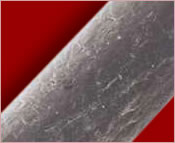
Low quality hair with no cuticle
Lower Hair Quality
When human hair is collected without considering cuticle direction and is simply placed in a bag, the hair will interlock like Velcro. It will lead to tangled and matted hair with no healthy shine. Before this hair can be used it is chemically treated to remove all cuticles. To give it back its natural look and shine the hair is covered by a silicon layer.This hair can feel and look beautiful when it is used for the first time but after washing it a few times the silicon layer comes of and it will lose its shine, become dry, and tangles. It is usually just labeled as "Human hair" and is less expensive.
Where does the hair come from?
Hair is also specified by the location where it comes from. Indian and European hair is most popular and usually of good quality. Depending on how the hair is collected you can have Indian Remy hair or just Indian hair. This applies to other locations as well of course.European Human Hair
European hair comes mainly from Eastern Europe (Russia) and Italy. Because of its quality it is popular to use for extensions. Natural blonde or red hair is less common but it can be dyed in any color just like your own natural hair. Typical European human hair is relatively thin and has an oval cross-section.
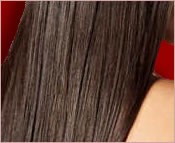
Beautiful healthy hair
Indian Hair
Indian hair has a very similar basic structure as European hair. In general this hair type is of a very high quality. However the method of collection is very essential. India is one of the largest exporters of human hair. Indian temple hair is a name you will hear when you deal with hair extensions. Many Indian women offer their hair in Hindu temples as a sign of respect and gratitude. This hair is bundled and bagged with cuticles lined up for each individual separately. Collected in the right way this hair is one of the best hair types available for use in a human hair extension.Not all Indian hair is Remy hair.
Most of the Indian hair is shipped to China but other countries are also important.
Latin American Hair
Latin American hair (mainly from Brazil and Argentina) is relatively new to the market. Just as Indian hair it has a similar basic structure as European hair. The use of Latin American hair has been growing the last couple of years.Asian Hair
Asian hair comes mainly from China. It is very often used for human hair extensions. This hair is thicker than European hair and has a round cross-section. It is dark black.
To prepare this hair for use in hair extensions it is usually chemically treated to make it thinner and lighter. This will lower the quality. This hair is usually less expensive.
Some factories mix Asian hair with Indian Remy hair to make it cheaper. If you want 100% Remy hair make sure that it is not mixed.
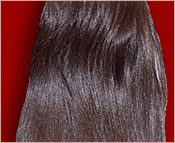
Yaki hair
Yaki Hair
Yaki hair is hair that is designed to have a similar texture as relaxed African-American or Caribbean hair so it looks and feels the same. It can be chemically treated human hair or synthetic. It is a cheaper hair.It comes in 4 basic textures:
Silky Yaki
Is the light and smooth. It has the African-American hair look after it has been relaxed and flat ironed.
Regular Yaki
Is like Silky Yaki but less silky and smooth.
Kinky Yaki
Has the African-American hair look that has been blow dried straight.
Coarse Yaki
Has a coarse texture. It looks and feels like unprocessed natural African-American hair.
It comes in two types: Wavy Coarse Yaki and Curly Coarse Yaki.
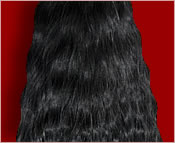
Synthetic hair
Synthetic Hair
Synthetic hair is in general the cheapest hair available. It is man-made fiber that is made to look like your own hair. It produces a different sheen than human hair, moves differently and therefore does not blend as well with human hair.
New fibers are developed continuously and synthetic hair is now better resistant to heat and has an appearance closer to human hair than ever before. It comes in a large variety of colors. Sometimes this hair is mixed with human hair and than used for a human hair extension. This is not the way to do it of course, both hair types need a different after care.
With the constant improvements that are made there could be a moment that fibers can replace natural hair.
----------
The majority of hair sold today is non-cuticle hair, which is less expensive. If you want to spend less money on your hair extension this could be fine for you as long as you realize that this hair will probably start matting, tangling and become dry a lot sooner than a higher quality hair.
Indian and European Remy virgin hair is of the highest quality and very popular but it is also the most expensive.
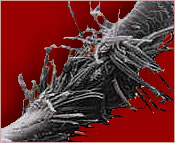
Hair damaged by overheating
Overheating
Overheating is one of your hair's biggest enemies, the damage can be as deep as the cortex which is the center of the hair. Be careful not to use too much heat when you use a blow dryer or curling iron. It is best to let your hair dry naturally. Chemical treatments like color and perm can be harmful as well. Go to your stylist for advise, they should know what is best for your hair. Brush your hair gentle to prevent damage. This is not just better for your hair extensions but it will also keep your own hair healthier.Before having hair extensions make sure that you talk to your stylist about the hair that will be used.


